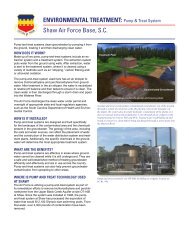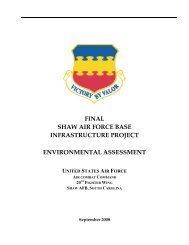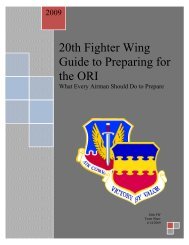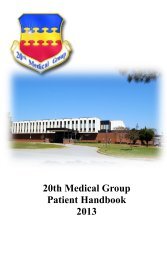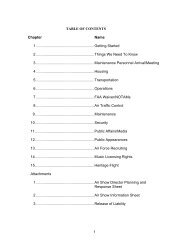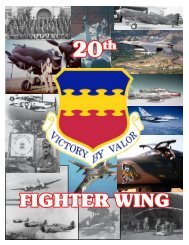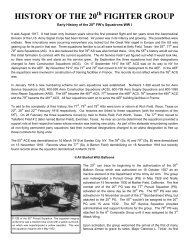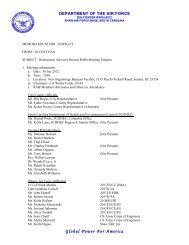20th
HISTORY OF THE 20th FIGHTER WING - Shaw Air Force Base
HISTORY OF THE 20th FIGHTER WING - Shaw Air Force Base
Create successful ePaper yourself
Turn your PDF publications into a flip-book with our unique Google optimized e-Paper software.
and General Staff School at Fort Leavenworth, Kansas, and the second during the American Legion Convention<br />
in New York. These demonstrations illustrated the effectiveness of newly developed pursuit and attack tactics<br />
and the significant firepower unleashed by A-17 and P-26 aircraft.<br />
First Closed Cockpit Fighter<br />
The <strong>20th</strong> Pursuit Group acquired its first aircraft with a closed cockpit, the Curtis P-36 Mohawk, in September<br />
1938. The P-36 had a 1,050 horse power engine, and a top speed of 303 miles per hour. It could carry up to 400<br />
pounds of bombs on its undercarriage.<br />
P-36A formation showing all three squadrons of the<br />
<strong>20th</strong> Pursuit Group’s aircraft. L-R: 77th, 55th and<br />
79th with red, blue and yellow nose bands respectively.<br />
The P in PT identifies the aircraft as pursuit<br />
and the T, being the <strong>20th</strong> letter in the alphabet, identifies<br />
the aircraft as from the <strong>20th</strong> Pursuit Group.<br />
On Nov. 15, 1939 the <strong>20th</strong> moved to Moffett Field, California,<br />
stayed there less<br />
than one year,<br />
and moved again<br />
on Sep. 9, 1940<br />
to Hamilton Field,<br />
also in California. At<br />
Hamilton the group<br />
changed aircraft<br />
once again, this time<br />
to the Curtis P-40<br />
Warhawk. This was<br />
the top of the line<br />
pre‐World War II<br />
pursuit fighter. It had<br />
P-36A of the 77th Pursuit Squadron with maintenance<br />
crew.<br />
Photo from Floyd Huffman<br />
a range of 750 miles,<br />
a top speed of 343<br />
miles per hour, and six .50 caliber machine guns in the wings.<br />
Several events in 1941 marked the group’s assignment at Hamilton Field. Deployed flights spent the first part of<br />
1941 at Muroc Lake, California, conducting bombing and gunnery training. In January 1941 the group gained Lt.<br />
Col. Ira C. Eaker as its commander. Colonel (later Lt. Gen.) Eaker remained with the group until September 1941.<br />
In September 1941 the <strong>20th</strong> deployed to Esler Field, Louisiana,<br />
Groton, Conn. And Morris Field, N.C. conducting maneuvers. In<br />
December 1941, the <strong>20th</strong> returned to Hamilton Field, California.<br />
Two days later the Japanese attacked Pearl Harbor, Hawaii.<br />
P-40 of the 55th Pursuit Squadron at Oakland Municipal<br />
Airport in 1940. This is not a B model, but<br />
just a P-40. No production A models were made.<br />
B models had the star insignia on the fuselage and<br />
no tail stripes. This model P-40 sports two .50 cal.<br />
machine guns in the nose and one .30 machine gun<br />
in each wing.<br />
Photo from Bill Larkins<br />
on the east coast the group split into its component squadrons<br />
which deployed to various locations on the east coast, with group<br />
headquarters temporarily established at Morris Field, N. C. The<br />
group’s mission at this time was to act as a training unit to create<br />
The 20 PG made several station moves following the United<br />
States’ declaration of war on Japan. Until February 1942 the<br />
<strong>20th</strong> performed air<br />
defense operations<br />
in the San Francisco<br />
Bay area. In October<br />
1941, the group<br />
returned to the east<br />
coast initially to<br />
Wilmington, N. C.,<br />
and then to Morris<br />
Field, N. C. While<br />
<strong>20th</strong> Fighter Wing History --- Page Number .<br />
P-43 Lancer 77 FS Spartanburg, South Carolina<br />
Spring 1942.<br />
Photo from Arthur Harszy



